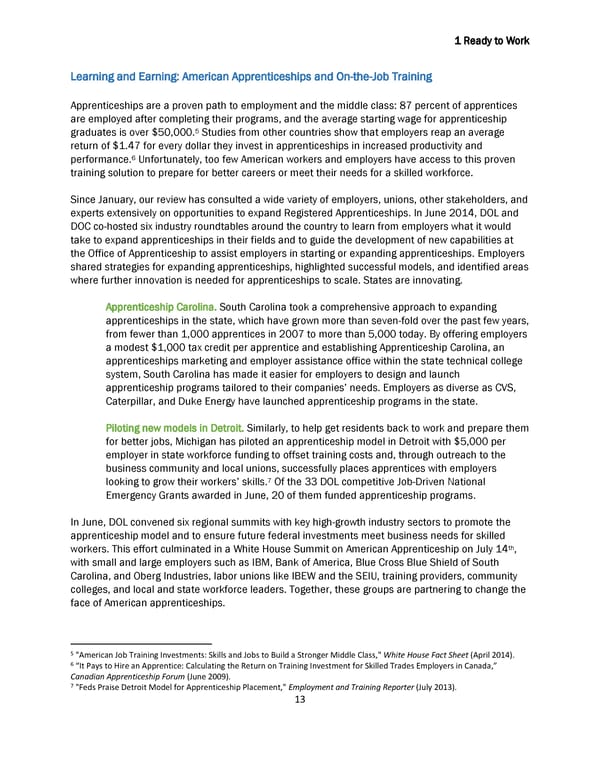1 Ready to Work Learning and Earning: American Apprenticeships and On-the-Job Training Apprenticeships are a proven path to employment and the middle class: 87 percent of apprentices are employed after completing their programs, and the average starting wage for apprenticeship 5 graduates is over $50,000. Studies from other countries show that employers reap an average return of $1.47 for every dollar they invest in apprenticeships in increased productivity and 6 performance. Unfortunately, too few American workers and employers have access to this proven training solution to prepare for better careers or meet their needs for a skilled workforce. Since January, our review has consulted a wide variety of employers, unions, other stakeholders, and experts extensively on opportunities to expand Registered Apprenticeships. In June 2014, DOL and DOC co-hosted six industry roundtables around the country to learn from employers what it would take to expand apprenticeships in their fields and to guide the development of new capabilities at the Office of Apprenticeship to assist employers in starting or expanding apprenticeships. Employers shared strategies for expanding apprenticeships, highlighted successful models, and identified areas where further innovation is needed for apprenticeships to scale. States are innovating. Apprenticeship Carolina. South Carolina took a comprehensive approach to expanding apprenticeships in the state, which have grown more than seven-fold over the past few years, from fewer than 1,000 apprentices in 2007 to more than 5,000 today. By offering employers a modest $1,000 tax credit per apprentice and establishing Apprenticeship Carolina, an apprenticeships marketing and employer assistance office within the state technical college system, South Carolina has made it easier for employers to design and launch apprenticeship programs tailored to their companies’ needs. Employers as diverse as CVS, Caterpillar, and Duke Energy have launched apprenticeship programs in the state. Piloting new models in Detroit. Similarly, to help get residents back to work and prepare them for better jobs, Michigan has piloted an apprenticeship model in Detroit with $5,000 per employer in state workforce funding to offset training costs and, through outreach to the business community and local unions, successfully places apprentices with employers 7 looking to grow their workers’ skills. Of the 33 DOL competitive Job-Driven National Emergency Grants awarded in June, 20 of them funded apprenticeship programs. In June, DOL convened six regional summits with key high-growth industry sectors to promote the apprenticeship model and to ensure future federal investments meet business needs for skilled th workers. This effort culminated in a White House Summit on American Apprenticeship on July 14 , with small and large employers such as IBM, Bank of America, Blue Cross Blue Shield of South Carolina, and Oberg Industries, labor unions like IBEW and the SEIU, training providers, community colleges, and local and state workforce leaders. Together, these groups are partnering to change the face of American apprenticeships. 5 "American Job Training Investments: Skills and Jobs to Build a Stronger Middle Class," White House Fact Sheet (April 2014). 6 “It Pays to Hire an Apprentice: Calculating the Return on Training Investment for Skilled Trades Employers in Canada,” Canadian Apprenticeship Forum (June 2009). 7 "Feds Praise Detroit Model for Apprenticeship Placement," Employment and Training Reporter (July 2013). 13
 Biden Ready to Work White Paper 7/22/14 Page 12 Page 14
Biden Ready to Work White Paper 7/22/14 Page 12 Page 14